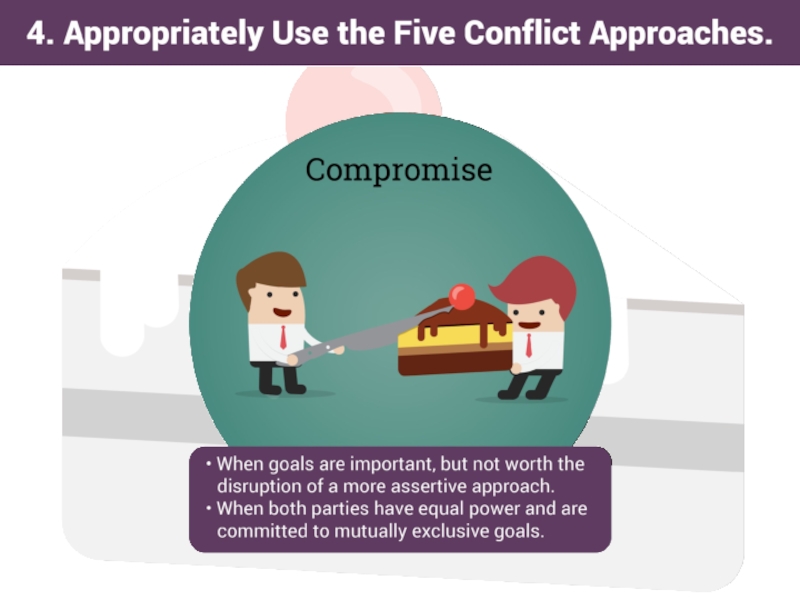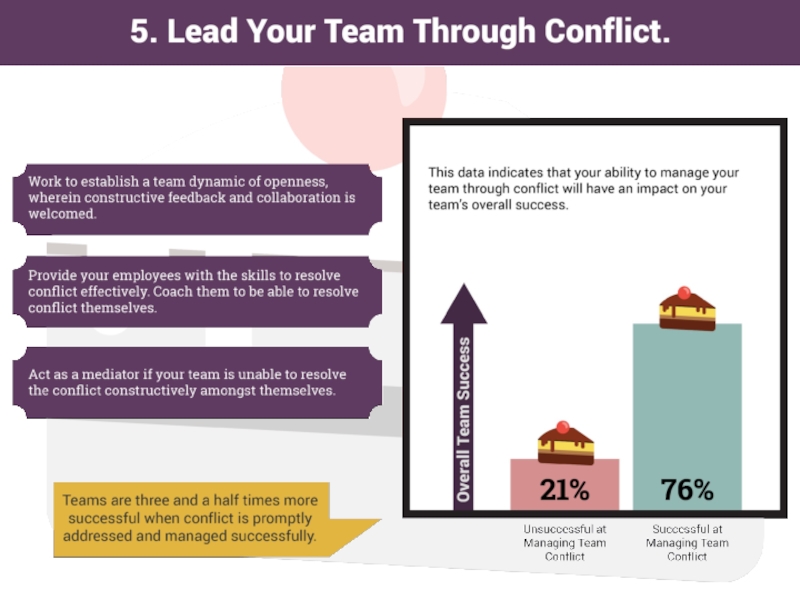to positively impact your organization.
• According to a study conducted by the American Management Association, managers have reported spending 18% to 26% of their time dealing with conflicts, depending on the level of their organization (Thomas).
• This is a significant investment of time. The ability to surface interpersonal and team conflicts quickly and settle them effectively is crucial to improve efficiency and productivity levels.
Select the appropriate approach to manage the conflict and achieve a constructive resolution.
There are five approaches to conflict – each are appropriate for specific situations. Using the correct approach at the right time is fundamental to successful resolution.
Conflict does not have to be negative.
The presence of conflict in an organization can actually be a very positive thing – the ability to freely express opinions and openly debate can lead to better, more strategic decision making.
High impact conflict resolution is the ability to resolve conflicts while minimizing the costs or collateral damage of the conflict.
• Knowing the best approach to take to resolve the conflict, given the situation.
• Learning how to resolve conflict without being perceived as antagonistic, evasive, or weak.
Use McLean & Company’s conflict resolution framework to effectively deal with conflict:
Make the case – why train on conflict resolution? Positive outcomes of successful conflict resolution techniques include:
1. Improved efficiency and productivity
Training on conflict management and improving managerial skills at surfacing conflict quickly and settling it cleanly will improve efficiency and productivity levels.
2. Improved organizational culture
Poorly-handled conflicts impact organizational culture. They can interfere with positive work relationships, create stress, and polarize teams. They lead to increased absenteeism and turnover rates.
3. Improved ability to make strategic decisions
Framing conflicts as collaborations that find the best solution for the organization as a whole can help generate a number of possible solutions and a more strategic selection of the best possible outcome.
Conflict in the workplace may be more prevalent than you think
• Feelings of co-worker backstabbing are negatively correlated with productivity.
Determine your conflict resolution approach Common causes of conflict situations include:
• Poor communication
• Different work methods
• Different goals
• Personality clash
• Stress
• Different perspectives
There are five approaches to conflict:
1. Force
• “I win, you lose.”
• This approach is a desire to achieve one’s own ends, at the expense of someone else.
2. Avoid
• “I lose, you lose.”
• This approach is an indifference towards the concerns of both parties. It involves withdraw from or neglect of any party’s interest.
3. Accommodate
• “I lose, you win.”
• This approach is giving in to another’s concerns without making an effort to achieve one’s own ends.
4. Collaborate
• “I win, you win.”
• This approach is problem-solving and integrates each party’s concerns.
5. Compromise
• “I win a little, you win a little.”
• Both parties give something up, yet both parties gain something.
Engage in conflict constructively Before confronting the conflict, reflect on the situation.
• Prior to being in a conflict situation, take some time to self-reflect, so that you are more prepared to handle your next conflict.
• While in a conflict, reflect on your emotions – are you taking a reactive approach to the issue?
- Главная
- Разное
- Дизайн
- Бизнес и предпринимательство
- Аналитика
- Образование
- Развлечения
- Красота и здоровье
- Финансы
- Государство
- Путешествия
- Спорт
- Недвижимость
- Армия
- Графика
- Культурология
- Еда и кулинария
- Лингвистика
- Английский язык
- Астрономия
- Алгебра
- Биология
- География
- Детские презентации
- Информатика
- История
- Литература
- Маркетинг
- Математика
- Медицина
- Менеджмент
- Музыка
- МХК
- Немецкий язык
- ОБЖ
- Обществознание
- Окружающий мир
- Педагогика
- Русский язык
- Технология
- Физика
- Философия
- Химия
- Шаблоны, картинки для презентаций
- Экология
- Экономика
- Юриспруденция






















